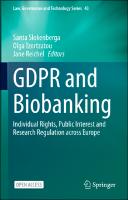GDPR and Biobanking
Individual Rights, Public Interest and Research Regulation across Europe
| dc.contributor.editor | Slokenberga, Santa | |
| dc.contributor.editor | Tzortzatou, Olga | |
| dc.contributor.editor | Reichel, Jane | |
| dc.date.accessioned | 2021-01-13T08:57:17Z | |
| dc.date.available | 2021-01-13T08:57:17Z | |
| dc.date.issued | 2021 | |
| dc.identifier | ONIX_20210113_9783030493882_31 | |
| dc.identifier.uri | https://library.oapen.org/handle/20.500.12657/46125 | |
| dc.description.abstract | This open access book focuses on the discrepancies in biobank research regulations that are among the most significant hurdles to effective research collaboration. The General Data Protection Regulation (GDPR) has established stringent requirements for the processing of health and genetic data, while simultaneously allowing considerable multi-level exceptions for the purposes of scientific research. In addition to directly applicable exceptions, the GDPR places the regulatory responsibility for further defining how the Member States strike a balance between the individuals' rights and the public interest in research within their national legal orders. Since Member States' approaches to the trade-off between data subjects' rights on the one hand, and appropriate safeguards on the other, differ according to their ethical and legal traditions, their data protection requirements for research also differ considerably. This study takes a comprehensive approach to determine how the GDPR affects regulatory regimes on the use of personal data in biobanking research, with a particular focus on the balance between individuals' rights, public interest and scientific research. In this regard, it has two main goals: first, to scrutinize the GDPR research regime, its objective and constitutive elements, the impact it has on biobanking, and its role in a changing EU landscape post-Brexit; and second, to examine how various exceptions have been operationalized nationally, and what challenges and opportunities this diversification entails. The book not only captures the complexity GDPR creates for biobanking, but also sheds light on various approaches to tackling the corresponding challenges. It offers the first comprehensive analysis of GDPR for biobanking, and the most up-to-date overview of the national biobank regulatory frameworks in Europe. | |
| dc.language | English | |
| dc.relation.ispartofseries | Law, Governance and Technology Series | |
| dc.subject.classification | thema EDItEUR::L Law::LB International law | en_US |
| dc.subject.classification | thema EDItEUR::U Computing and Information Technology::UR Computer security | en_US |
| dc.subject.classification | thema EDItEUR::M Medicine and Nursing::MF Pre-clinical medicine: basic sciences::MFN Medical genetics | en_US |
| dc.subject.other | European Law | |
| dc.subject.other | Systems and Data Security | |
| dc.subject.other | Human Genetics | |
| dc.subject.other | Data and Information Security | |
| dc.subject.other | Medical Genetics | |
| dc.subject.other | Biobank research | |
| dc.subject.other | GDPR | |
| dc.subject.other | Article 89 GDPR | |
| dc.subject.other | Data protection | |
| dc.subject.other | Informational privacy | |
| dc.subject.other | ELSI in genetics and genomics | |
| dc.subject.other | Human specimens | |
| dc.subject.other | Research Governance | |
| dc.subject.other | Public interest | |
| dc.subject.other | Regulatory framework | |
| dc.subject.other | Open Access | |
| dc.subject.other | International law | |
| dc.subject.other | Computer security | |
| dc.subject.other | Network security | |
| dc.title | GDPR and Biobanking | |
| dc.title.alternative | Individual Rights, Public Interest and Research Regulation across Europe | |
| dc.type | book | |
| oapen.identifier.doi | 10.1007/978-3-030-49388-2 | |
| oapen.relation.isPublishedBy | 6c6992af-b843-4f46-859c-f6e9998e40d5 | |
| oapen.imprint | Springer | |
| oapen.series.number | 43 | |
| oapen.pages | 434 |

